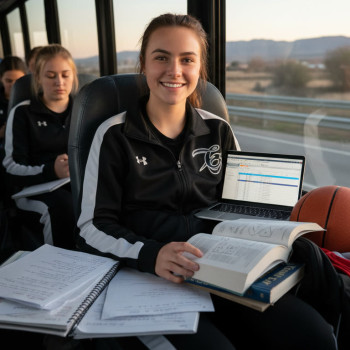Why Celebrating Wins Matters More Than You Think
If you’ve ever sat down after a long study session and felt…nothing, you’re not alone. We’re trained to chase the next assignment, the next practice test, the next deadline. But celebrating wins — and crucially, documenting what worked — is one of the smartest academic moves a student can make. Especially for AP preparation, where steady improvement and strategic reflection beat last-minute cramming every time.
Documenting wins isn’t about bragging. It’s a study technique that builds confidence, clarifies what actually helps, and creates a repeatable roadmap you can return to when things get hard. Think of it like building a personalized manual for your brain: every note you take, every micro-strategy that helps you remember a tricky concept, becomes a tool you can use again.

Psychology Behind the Practice
From a psychological perspective, acknowledgement and recording are powerful. Celebrating small wins releases dopamine, which reinforces the behaviors that led to the success. Documenting creates cognitive closure: instead of letting a fleeting moment of success evaporate into the stream of to-dos, you make it concrete. That concreteness helps memory consolidation and makes it easier to replicate the approach later.
What Counts as a Win in AP Prep?
Not every win is a perfect score or a dramatic breakthrough. In fact, the smaller ones are often the most useful. Here are examples of wins you should notice and record:
- Understanding a previously confusing concept (e.g., realizing the chain rule clicks when you rewrite the function differently).
- Completing a timed practice section with improved pacing.
- Improving a free-response question from a 2 to a 4 on rubrics after revision.
- Finding a study format that helps (flashcards, mind maps, teach-back method).
- Figuring out environmental tweaks that help focus (headphones, time of day, 25-minute cycles).
- Discovering a useful resource: a College Board practice prompt, an AP Daily video, or a textbook explanation that finally made sense.
How Simple Documentation Makes These Wins Actionable
When you write down the win, don’t stop at the result. Record the context and the variables. For example:
- What exactly improved (score, speed, understanding)?
- What did you do differently? (resource, schedule, note-taking style)
- When did you study it? (time of day, length of session)
- How confident are you that this will generalize to other topics?
That short context turns a fuzzy memory into a replicable strategy.
Practical Templates: How to Document Wins (and Use the Data)
Below are three templates you can copy into a physical notebook or a notes app. Keep your entries brief — 1–3 lines for the win, and 2–4 bullets for context. The goal is speed and consistency.
Template A — Quick Win Log
- Date:
- Win (one sentence):
- What I did that helped (one or two items):
- Where I’ll use this again:
Template B — Deep Reflection (weekly)
- Week of:
- Top 3 Wins this week:
- Why each win happened (short analysis):
- Adjustments to make next week:
Template C — Exam Practice Record
- Date / Test section:
- Score / Time:
- Errors (common themes):
- Technique that helped:
- Action items for next practice:
Data Table: Weekly Win Tracker
The simple table below helps you visualize trends across multiple weeks. Fill one row per week and review the table every two weeks to spot patterns.
| Week | Top Win | Method Used | Time Spent | Confidence Change (1–10) | Plan for Next Week |
|---|---|---|---|---|---|
| Week 1 | Mastered equilibrium problems | Worked 5 past FRQs, teacher feedback | 6 hours | +2 | Practice 3 timed FRQs |
| Week 2 | Improved MC pacing | Timed 30-min blocks, Pomodoro | 4 hours | +1 | Simulate full-length section |
| Week 3 | Stronger essay structure | Outline templates, peer review | 5 hours | +3 | Refine thesis statements |
How to Turn Wins Into a Study Engine
Recording is the first step. Turning that record into reliable gains is the second. Here’s a step-by-step plan to convert your documented wins into habitual improvement:
- Weekly Review: Every Sunday, read your win log. Circle entries that repeat and underline strategies that seem most effective.
- Prioritize: Choose 2–3 strategies to reuse the following week. Keep it realistic — consistency beats intensity.
- A/B Test: When possible, test two approaches on similar tasks (e.g., flashcards vs. self-explaining) and document outcomes.
- Share and Teach: Teach a friend or study partner one small technique you documented. Teaching boosts memory and reveals gaps.
- Scale Up: If a small tweak consistently helps, scale it to related areas. A timing trick that improves MC pacing in Biology may help in Chemistry too.
Real-World Example
Jane, an AP U.S. History student, noticed she retained core themes better when she created a one-paragraph summary after every chapter and revised it the next day. She logged this win, noting she wrote summaries at 9 p.m. after a short walk. Over six weeks, she replaced passive rereading with this active summarization, and her free-response answers became sharper and faster. Her documented win turned into a study habit that reduced her review time by an hour a week while improving scores on practice prompts.
Using Tools Effectively: Apps, Notebooks, and Sparkl’s Help
There’s no one “right” tool — the best one is the one you use. Still, it’s helpful to match the tool to the task:
- Quick Wins: Use sticky notes or a dedicated section in your notebook for immediate capture.
- Weekly Reflection: A notes app or a digital document (consistent file name) makes searching easier.
- Quantitative Tracking: Simple spreadsheets or the table above help you spot patterns.
For many students, occasional guided support makes documenting and analysis easier. Personalized tutoring — for example, Sparkl’s 1-on-1 guidance — can accelerate this process by helping you identify which wins matter most, suggesting tailored study plans based on your logged data, and providing expert feedback on practice FRQs or pacing strategies. When tutors use your documented wins, they can craft sessions that build directly on your strengths rather than repeating what hasn’t worked.
How Tutors Turn Wins Into Strategy
A strong tutor won’t just tell you to celebrate; they’ll ask targeted questions about your win logs, show you patterns you might miss, and suggest experiments to further improve. If you’re using AI-driven insights and personalized tutoring together, you’ll get a blend of human intuition and data-backed suggestions — ideal for fine-tuning your approach in the months before an AP exam.
Common Pitfalls and How to Avoid Them
Even the best intentions can derail if you fall into patterns that make documentation feel like busywork. Here are common traps and practical fixes:
- Trap: Writing massive, infrequent entries that you never review. Fix: Capture wins quickly and review weekly for 10–15 minutes.
- Trap: Only logging perfect outcomes. Fix: Record near-misses and surprising insights — they’re often the most instructive.
- Trap: Rigidly following a method that worked once. Fix: Treat your log as a living guide; continuously test and adapt.
- Trap: Forgetting to celebrate. Fix: Build a small ritual — a sticker, a playlist, a 5-minute break — that marks the win.
Make It Social — Carefully
Sharing wins with a study group can create positive accountability, but be intentional. Share process-focused wins (“I started outlining essays for 10 minutes daily and saw fewer structure errors”) instead of raw scores, which can cause anxiety or comparison. Peer feedback also offers new perspectives on why a technique worked.
Linking Documented Wins to Measurable Score Improvements
When you track wins and methods over time, you can begin to connect specific practices to score changes. Use the table above to map weekly confidence changes and practice outcomes against score trends from full-length practice exams. In particular, pay attention to:
- Consistency signals: If a method consistently aligns with +1 or more on practice sections, prioritize it.
- Transferability: Does a method that improves one type of question help others? If yes, it’s high-value.
- Time investment vs. return: Some strategies have huge payoffs for small time commitments (active recall vs. rereading).
Remember that correlation isn’t guaranteed causation. That’s why careful documentation and small experiments are critical — they help isolate which changes drive improvements.
Example: Three-Month Plan That Leverages Documented Wins
This sample plan shows how to fold documentation into a realistic three-month AP prep sprint.
- Month 1 — Build Baseline
- Take one diagnostic practice exam.
- Start the Quick Win Log after each study session.
- Identify 3 recurring weaknesses and 2 strategies that appear effective.
- Month 2 — Test and Iterate
- Run A/B tests on study methods for two weaknesses (e.g., flashcards vs. concept maps).
- Weekly review meetings with yourself or a tutor to refine tactics.
- Scale up the most effective strategy into daily practice.
- Month 3 — Simulate and Solidify
- Simulate exam conditions once every 10–14 days and document results.
- Polish transfer skills (timing, essay templates, common problem types).
- Use your log to create a last-two-week plan that focuses on high-leverage wins.
Where Personalized Tutoring Fits In
Throughout this plan, a tutor can help you interpret the win log quickly and recommend targeted experiments. Sparkl’s approach of tailored study plans and expert tutors (paired with AI-driven insights) is an example of how structured support can reduce guesswork and help you focus on strategies that truly move the needle.
Celebration Rituals That Reinforce Momentum
Celebration doesn’t need to be elaborate. Small rituals make wins stick. Here are ideas that work well for students:
- Stickers or a visual progress bar on a wall calendar for every documented win.
- A 10-minute favorite break (coffee, short walk, playlist) after a focused session that led to a win.
- Monthly reflection Zoom or meet-up with a study buddy to share three wins and one plan.
- A “wins playlist”: add a song after each meaningful milestone. Over time, the playlist cues motivation.
Micro-Celebrations That Don’t Cost Time
When schedules are tight, even tiny rewards matter: close your laptop and stretch, change your study location for the next session, or switch to a different subject you enjoy for 20 minutes. The point is to mark the transition and give your brain a small reward signal.
Wrapping Up: Your Personal Roadmap to Confident AP Performance
AP exams test knowledge, but they also test strategy, endurance, and the ability to apply what you’ve learned under pressure. Documenting what worked is the bridge between raw hours studied and reliable performance. The process is simple: notice a win, capture the context, test whether it repeats, scale what helps, and celebrate along the way.
Make documentation lightweight and consistent. Use quick logs after sessions, a weekly review habit, and a simple table to visualize trends. Lean on personalized support when it makes sense — such as 1-on-1 tutoring — to fast-track the analysis of your wins and turn promising tactics into reliable gains. And remember: every small victory is cumulative. Two steps forward every week adds up to a confident stride on exam day.

Final Checklist: Start Documenting Today
- Set up a Quick Win Log method (notebook, app, or sticky notes).
- Record one win after every study session for one week.
- Do a 15-minute weekly review and pick two strategies to repeat.
- Run one small experiment (A/B test) for a weak area and log the result.
- Consider occasional 1-on-1 tutoring sessions to interpret your logs and refine your plan.
Start small, document honestly, and celebrate consistently. Over time, you’ll build a personalized playbook that makes AP success feel less like luck and more like a habit. Good luck — and enjoy tracking the wins; they’re more powerful than you think.


















No Comments
Leave a comment Cancel